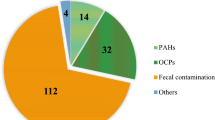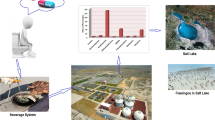Abstract
The Mediterranean wetlands are unique in biological diversity and they offer multiple benefits constituting a great water reserve for the planet and to produce biomass and nutrients for the trophic chain. However, the increasing human impact and the socio-economic development of the last decades have provoked important losses in these ecosystems. The work has been developed in the Natural Park of La Albufera (Valencia, Spain), which includes a coastal lagoon, marshlands, dunes and pinewoods, surrounded by rice fields in its non-urbanized part. In spite of this great ecological value, it suffers impacts derived from the high human and industrial occupation and of the hydrological contributions from the connected irrigation systems. The study has been focused on the development of a combined methodology based on environmental forensic principles to identify illicit drugs and its spatial sources and implications. Results show that rather than the pattern of population distribution the traditional irrigation system connected to location of sewage treatment plants is the way to introduce the illicit substances in the waters of the Natural Park.
Access provided by Autonomous University of Puebla. Download chapter PDF
Similar content being viewed by others
Keywords
1 Introduction
Mediterranean coastal wetlands are of great interest for their richness in biodiversity. They are also fragile systems because they are exposed to various human pressures such as farming systems (Readman et al. 1993) and urban sprawl (Li et al. 2010) that alter their ecological and environmental conditions.
Among other emerging contaminants, illicit drugs have also been detected in the aquatic environment. As for therapeutic substances, the main source of contamination for illicit drugs is human consumption. These substances are detectable in treated water and contaminate the receiving surface waters (Zuccato and Castiglioni 2009).
Some works have studied the presence of illicit substances in river systems and open water systems after passing through urban agglomerations and sewage treatment plants, although very little has been researched to analyze flow paths and water incorporation into permanent water bodies such as coastal lagoons. The aim of this work is the development of an integral methodology to evaluate the presence and spatial distribution of illicit drugs in surface water of the protected Natural Park of l’Albufera de Vaelncia wetland to obtain the background on how such substances travel from urban and agricultural systems to the protected area.
2 Study Area
The study has been applied to l’Albufera de Valencia Natural Park (Fig. 32.1), located in the east of the Iberian Peninsula. The Natural Park is surrounded by a very populated hinterland, due to the influence of the City of Valencia and its metropolitan area. Major threats come from the activities developed by a population of more than 1,200,000 inhabitants. Agriculture and intensive irrigation systems developed in and out of the limits of the Natural Park are important threats to the preservation of ecosystems and water quality.
The present Natural Park of l’Albufera is a territory of 274.4 km2, including its marine area. Due to secular alterations, within its limits a large proportion of the land is covered by rice fields, which occupy the primitive marshland, with only a few hectares still in their natural state (Soria et al. 2002). In the continental margins of the Natural Park, intensive irrigated agricultural gardens are also found. A shallow water lagoon is located in the centre of the Natural Park. It is almost circular in form and is an area of approximately 23.7 km2.
The hydrology of the Natural Park combines a complex human management system with natural contributions, as the water comes from the historic irrigation system, the main source of water inflows to the Natural Park. There is a very dense system of overland artificial channels for irrigation with waters mainly coming from the rivers of Jucar and Turia, which finally drains to the lake or directly to the sea.
3 Methodology
Methodology is based on an environmental forensics perspective integrating different sources and data formats (Taylor 2004). It is organised around two major procedures (Fig. 32.2): analysis of water samples and a spatial analysis with Geographical Information Systems (GIS).
Initial data consisted of (1) statistic information to municipal level on number of inhabitants and population density (inhabitants by square kilometre, h/km2) for the year 2008 provided by the Spanish institute of Statistics; (2) an updated 2008 digital layer on land cover distribution from the CORINE project (Bossard et al. 2000); (3) a digitized map with municipal boundaries; (4) a point map with the location of sewage waters treatment plants (STPs); (5) a digital layer of the traditional irrigation systems (drainage networks and areas) as stated by Hermosilla Pla (2006, 2007); and (6) 16 water samples spatially distributed over the Natural Park collected in fieldwork campaigns during the year 2008.
Water samples were further treated with a method using solid-phase extraction (SPE) and liquid chromatography tandem mass spectrometry (LC-MS/MS) for the simultaneous determination of 14 drugs of abuse and their metabolites (cocainics, amphetamine-like compounds, cannabinoids, and opiates; Vazquez-Roig et al. 2010).
From original tabular data and map layers, GIS procedures were applied to derivate new map overlays (artificial covers such as urban and industrial surfaces) and to obtain two municipal spatial indexes, the integrate percentage of urban and industrial covers and the population density.
To identify the presence of illicit drugs in traditional irrigation systems with geographical anthropogenic origins either GIS layers or results from the illicit drugs determination with the SPE and LC-MS/MS method were compared in the GIS environment.
4 Results and Discussion
The presence of illicit substances has been found in all out points analysed in the traditional irrigation water network of the Natural Park (Table 32.1 and Fig. 32.2), and corroborates that urban water still incorporates emerging contaminants, including illegal drugs after STPs treatment (Boleda et al. 2009; Postigo et al. 2010).
Most evidence has been found in cocainics COC and metabolites (BECG and ECGME), amphetamines (AMP and MDMA), methadone, codeine, morphine, and THC-COOH, the main metabolite of THC, which were determined in water samples at levels ranging from less than 0.14 to 78.78 ng/L. The highest concentrations were determined in the water samples collected at sample PM6, which can be related to direct spillage of residual waters from a close leisure zone.
The geographical presence of illegal substances can also be explained by a combination of water pathways and multiuse. Residual water from urban areas, after being treated in STPs, is introduced in the agricultural system for irrigation uses and finally drainage into the lake (Fig. 32.2). Traditional irrigation systems are vehicles to supply the presence of illegal substances into the Natural Park. So far, a spatial relationship between population concentration and artificial surfaces with the presence of drugs cannot be stated, although STPs drainage in the irrigation network has to be understood as the mean of illicit drugs presence in the Natural Park of l’Albufera.
5 Conclusions
The combined method using water samples and spatial analysis integrated under an environmental forensic approach has been effective to detect the presence of illicit drugs in the Natural Park o l’Albufera.
There is no clear evidence of a geographical trend based on population density or concentration or urbanized areas; in that case, further work should be done to establish the effectiveness of STPs in purifying contaminated waters with illicit substances.
The analysis has proven that the water paths of inflow waters to the Natural Park are related to the overlapping of traditional irrigation systems and networks with STPs.
References
Boleda MR, Galceran MC, Ventura F (2009) Monitoring of opiates, cannabinoids and their metabolites in wastewater, surface water and finished water in Catalonia, Spain. Water Res 43:1126–1136
Bossard M, Feranec J, Otahel J (2000) CORINE land cover technical guide – Addendum 2000. European Environment Agency, Copenhagen
Hermosilla Pla J (2006) Las Riberas del Xúquer: Paisaje y Patrimonio Valencianos. Generalitat Valenciana, Valencia
Hermosilla Pla J (2007) El patrimonio hidráulico del Bajo Turia: L’Horta de València. Generalitat Valenciana, Valencia
Li Y, Zhua X, Suna X, Wang F (2010) Landscape effects of environmental impact on bay-area wetlands under rapid urban expansion and development policy: a case study of Lianyungang, China. Landscape Urban Plan 94:218–227
Postigo C, López de Alga MJ, Barceló D (2010) Drugs of abuse and their metabolites in the Ebro River basin: occurrence in sewage and surface water, sewage treatment plants removal efficiency, and collective drug usage estimation. Environ Int 36:75–84
Readman JW, Albanis TA, Barcelo D, Galassi S, Tronczynski J, Gabrielides GP (1993) Herbicide contamination of mediterranean estuarine waters: results from a MED POL pilot survey. Mar Pollut Bull 26(11):613–619
Soria JM, Miracle MR, Vicente E (2002) Relations between physico–chemical and biological variables in aquatic ecosystems of the Albufera Natural Park (Valencia, Spain). Verhandlungen Internationale Vereinigung für Theoretische und Angewandte Limnologie 28:564–568
Taylor DA (2004) Environmental forensic files. Environ Health Persp 112(2):a88–a88
Vazquez-Roig P, Andreu V, Blasco C, Picó Y (2010) SPE and LC-MS/MS determination of 14 illicit drugs in surface waters from the Natural Park of L’Albufera (València, Spain). Anal Bioanal Chem 39(7):2851–2864
Zuccato E, Castiglioni S (2009) Illicit drugs in the environment. Philos Trans Roy Soc A 367:3965–3978
Acknowledgments
This work has been carried out in the scope of project HUCOMED CGL2008-01693/BTE and project GCL2007-66687-C02-01/BOS, both financed by the Spanish Ministry of Science and technology.
Author information
Authors and Affiliations
Corresponding author
Editor information
Editors and Affiliations
Rights and permissions
Copyright information
© 2013 Springer-Verlag Berlin Heidelberg
About this chapter
Cite this chapter
Aguilar, J.A.P., Andreu, V., Vázquez, P., Picó, Y. (2013). Presence of Illicit Drugs in Surface Waters of Protected Natural Wetlands Connected to Traditional Irrigation Systems and Urban Areas. In: Farfán González, H., Corvea Porras, J., de Bustamente Gutiérrez, I., LaMoreaux, J. (eds) Management of Water Resources in Protected Areas. Environmental Earth Sciences. Springer, Berlin, Heidelberg. https://doi.org/10.1007/978-3-642-16330-2_32
Download citation
DOI: https://doi.org/10.1007/978-3-642-16330-2_32
Published:
Publisher Name: Springer, Berlin, Heidelberg
Print ISBN: 978-3-642-16329-6
Online ISBN: 978-3-642-16330-2
eBook Packages: Earth and Environmental ScienceEarth and Environmental Science (R0)






